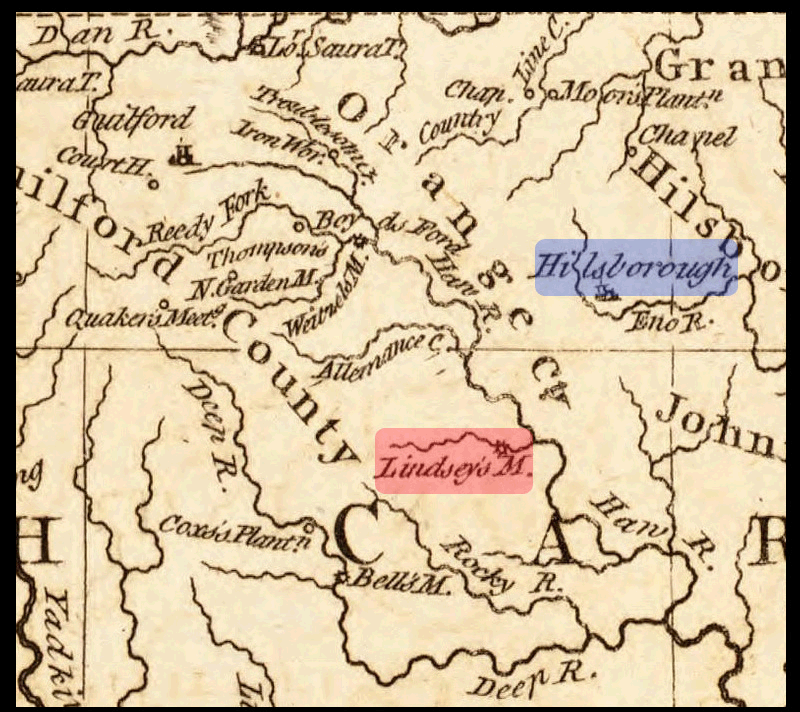Pre-Battle History
Following the Battle of Guilford Courthouse in North Carolina (March 15, 1781), General Charles Cornwallis and his 2000+ British Army exited North Carolina.
Left to fight in that area were local citizens, divided in their allegiances. The Patriots, also called Whigs and Rebels were against British control. Citizens who sided with the British were called Loyalists or Tories.
On September 12, 1781 during a daylight raid on Hillsboro (Hillsborough), North Carolina (See Map Below), ~600 Tories captured North Carolina Governor Thomas Burke, his staff, some residents, and some Continental officers and militia officers. One of the captured militiamen was Sergeant Henry Albright (#99). The Tories were led by Colonels David Fanning and Hector McNeill. After capture, the intent of the Tories was to march the Rebel prisoners to Wilmington N.C. and turn them over to the British Army.
Governor Burke was an important target because he was a Rebel and a government leader. Prior to his capture, he had been enlisting help to supply goods for the war effort, directing militia, and providing intelligence about enemy movement and location to the Patriots.
As a response to the Governor and others being captured, three hundred local Patriot Militia, lead by Brigadier General John Butler and Robert Mebane, organized themselves to ambush the Tories the next day at Lindley’s Mill (See Map Above), and perform a rescue. Ludwick Albright (#111) was one of the militiamen. Lindley’s Mill was a water grist mill on Cane Creek, located on the south side of Haw River. As shown at left, the location of the battle is indicated by this present day sign.
The Battle
As the Tories approached Lindley’s Mill, the Patriot Militia surprised them. Tory Colonel McNeill and several other Tories at the head of the march were killed. Under guard, Rebel prisoners were whisked away to a nearby barn. The Tories regrouped and Fanning and a large company forded the creek upstream of Butler’s position, attacked the Patriot Militia from their flank, and put the Patriots on the defensive. The battle lasted 4 hours. Both sides ran out of ammunition. Butler ordered his men to retreat due to the casualty count. In spite of the order to retreat, some Patriots continued holding their ground, but were finally dislodged by Fanning. Fanning threatened to kill the prisoners if the Patriots attempted to free them. The result of this battle: the rescue attempt of the governor failed. Instead, the governor and others were marched to Wilmington, NC where they arrived on September 24th. Prisoners were sent to various places by the British Soldiers. Governor Burke was imprisoned on James Island in South Carolina. He later escaped.
Between 200 and 250 men were killed or wounded in the battle. Fanning was one of those who were severely wounded.
Battle Casualities and Losses
Patriot Militia
24 killed
90 wounded
10 captured
27 killed
90 wounded
Although the battle was a loss for the Patriots, some historians believe the capture of Governor Burke and the defeat of the Patriots did not dampen Patriot sediments, but instead encouraged a growth in Patriot sentiment, which helped lead to Cornwallis’ surrender at Yorktown the next month (October 19, 1781).
[Note: Ludwick Albright (#111) and Henry Albright (#99) were first cousins. Both were grandsons of John Albright (#393/433/441) and Anna Barbara Gossauer (#394/434/442]).
Pension records show that Henry was a sergeant in the command of Captain James Trousdale and Lieutenant John Campbell when he was captured at Hillsborough on September 12, 1781. He was marched with other prisoners to Wilmington, NC and put on a prison ship that went to Charlestown, S.C.. He remained on the ship for about ll months, was exchanged July 1782, and arrived home August 6.
Ludwick served under Major O’Neal and General Butler. He served under Colonel Robert Mebane at Lindley Mill.
Both Ludwick and Henry are G-G-G-G Grandfathers of the webmaster.]
[Note: References: Wikipedia; The Battle at Lindley’s Mill, by Stewart E. Dunaway, 2009; Pension Application of Henry Albright #S6485, September 14, 1832, Pension Application by Elizabeth Albright for her deceased husband Ludwick Albright #W5609, 1840.]
Contact person for this website is Susan Snyder: susanleachsnyder@gmail.com

